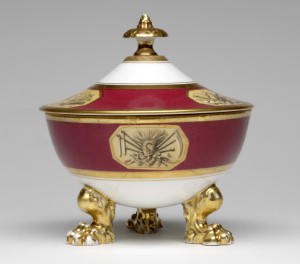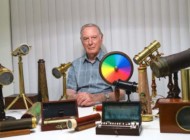
Among his many sterling qualities, David L. Barquist, the H. Richard Dietrich, Jr, curator of American decorative arts at the Philadelphia Museum of Art, has deep expertise in the arts of entertaining, from historic silver and glass to porcelain tableware made for and used by American presidents, George Washington to Barack Obama. Barquist recently oversaw the installation of the museum’s new McNeil American Presidential China Gallery, drawn from 500 pieces collected and donated to the institution by Robert L. McNeil Jr in 2006. The curator’s encyclopedic knowledge of the accoutrement of presidential pomp and privilege was on full display in a recent conversation.
How was the McNeil Collection formed?
Bob bought his first piece, a Society of the Cincinnati service plate ordered for President Washington in 1789, from Spring Mill Antiques in Conshohocken, Penn., in 1960. His original interest in the Founding Fathers is what led him to presidential china. We selected just under 200 pieces of china from his collection, plus a few pieces of glass, for the new installation. Presidential china as Bob defined it encompasses both objects used for entertaining in the White House and things owned by the presidents personally before or after they were in office. Only the holdings of the Smithsonian and the White House surpass this collection.
How did this china come to be on the market?
Until the Twentieth Century, and particularly until the formation of the White House Historical Association, it was common practice to sell unwanted furnishings. Barrels of old White House china were part of an epic auction that took place during the Chester Arthur administration. Many of the rare pieces in the McNeil Collection were acquired at that sale in 1882 by a fellow named Rear Admiral Francis Dickens. Of course, there has always been a certain amount of attrition at state dinners. I once wondered about the enormous Mottahedeh ashtrays of recent years in the Diplomatic Reception Rooms at the State Department. I was told they were huge so guests couldn’t pocket them.
Earliest piece on view?
A blue and white Chinese export plate that was part of the “common china” owned by George and Martha Washington. Washington had been buying Chinese porcelain well before the War for Independence, so it predates the United States.
Latest piece in the display?
We have a cup and saucer that was made for Ronald Reagan’s use on Air Force One. In the Twentieth Century, services were made for entertaining on the presidential yacht and, from Truman on, the presidential airplanes now called Air Force One.

Sugar bowl and cover for James Monroe (president 1817-1825), made by the partnership of Dagoty and Honoré, Paris, 1817. Porcelain with printed, enamel and gilt decoration. Gift of the McNeil Americana Collection, Philadelphia Museum of Art.
Rarest items?
The dessert stands from the Andrew Jackson state service in the McNeil collection are the only pieces presently known to survive from that service. Some of the Washington pieces are equally rare survivors. There is a caudle cup and stand, as well as a plate from the Martha Washington “States” service. We also have some of the bisque-fired classical porcelain figures that Gouverneur Morris bought for Washington in Paris in 1790. They are the only ones outside Mount Vernon and descendants of the Custis family.
Most beautiful?
I love the Rutherford B. Hayes service, designed by Theodore Russell Davis in 1879 and made by Haviland & Co., in Limoges, France. The service is exuberantly Victorian, with tremendous richness, variety and color. The Lyndon Johnson state service, designed by Lady Bird with Van Day Truex of Tiffany & Co., is really beautiful. In the center of each dessert plate is one of 50 state flowers.
What about glass?
Bob had a few pieces of glass from the Lincoln service and what has been identified as the Jackson service. The Jackson glass was made by Bakewell & Company of Pittsburgh. The Lincoln service is Dorflinger Glass, then located in Brooklyn. We also have a tumbler from the Benjamin Harrison glass service, also made by Dorflinger.
Any china painters among the first ladies?
Caroline Harrison, Benjamin Harrison’s wife. She participated in the design of the Harrison state service, another beautiful service that was Jackie Kennedy’s favorite. Mrs Harrison was also the first to poke around the White House looking for pieces of historical china. The White House china collection was formally organized under Mrs Theodore Roosevelt, who displayed pieces in Gustav Stickley cabinets on the ground floor of the White House.
What might the Trump service look like?
I suspect it will have gold. Many of the services do.
What else are you working on?
We hope to bring out volume one of our planned four-volume catalog of the Philadelphia Museum of Art’s American silver collection, which has never been published, in 2017. I joined Bea Garvan on what is still very much her project when I arrived at the museum 12 years ago. In January 2017, the museum begins work on brand-new galleries for the American collections from the Seventeenth Century up to about 1825. Other than ceiling supports, we won’t be constrained by any existing architecture. It’s an amazing opportunity to start fresh.
-Laura Beach




